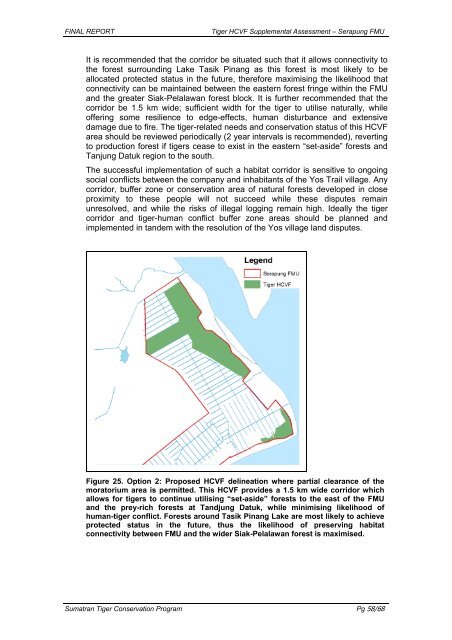A Supplemental HCVF Assessment on the Sumatran Tiger ...
A Supplemental HCVF Assessment on the Sumatran Tiger ...
A Supplemental HCVF Assessment on the Sumatran Tiger ...
Create successful ePaper yourself
Turn your PDF publications into a flip-book with our unique Google optimized e-Paper software.
FINAL REPORT <strong>Tiger</strong> <str<strong>on</strong>g>HCVF</str<strong>on</strong>g> <str<strong>on</strong>g>Supplemental</str<strong>on</strong>g> <str<strong>on</strong>g>Assessment</str<strong>on</strong>g> – Serapung FMU<br />
It is recommended that <strong>the</strong> corridor be situated such that it allows c<strong>on</strong>nectivity to<br />
<strong>the</strong> forest surrounding Lake Tasik Pinang as this forest is most likely to be<br />
allocated protected status in <strong>the</strong> future, <strong>the</strong>refore maximising <strong>the</strong> likelihood that<br />
c<strong>on</strong>nectivity can be maintained between <strong>the</strong> eastern forest fringe within <strong>the</strong> FMU<br />
and <strong>the</strong> greater Siak-Pelalawan forest block. It is fur<strong>the</strong>r recommended that <strong>the</strong><br />
corridor be 1.5 km wide; sufficient width for <strong>the</strong> tiger to utilise naturally, while<br />
offering some resilience to edge-effects, human disturbance and extensive<br />
damage due to fire. The tiger-related needs and c<strong>on</strong>servati<strong>on</strong> status of this <str<strong>on</strong>g>HCVF</str<strong>on</strong>g><br />
area should be reviewed periodically (2 year intervals is recommended), reverting<br />
to producti<strong>on</strong> forest if tigers cease to exist in <strong>the</strong> eastern “set-aside” forests and<br />
Tanjung Datuk regi<strong>on</strong> to <strong>the</strong> south.<br />
The successful implementati<strong>on</strong> of such a habitat corridor is sensitive to <strong>on</strong>going<br />
social c<strong>on</strong>flicts between <strong>the</strong> company and inhabitants of <strong>the</strong> Yos Trail village. Any<br />
corridor, buffer z<strong>on</strong>e or c<strong>on</strong>servati<strong>on</strong> area of natural forests developed in close<br />
proximity to <strong>the</strong>se people will not succeed while <strong>the</strong>se disputes remain<br />
unresolved, and while <strong>the</strong> risks of illegal logging remain high. Ideally <strong>the</strong> tiger<br />
corridor and tiger-human c<strong>on</strong>flict buffer z<strong>on</strong>e areas should be planned and<br />
implemented in tandem with <strong>the</strong> resoluti<strong>on</strong> of <strong>the</strong> Yos village land disputes.<br />
Figure 25. Opti<strong>on</strong> 2: Proposed <str<strong>on</strong>g>HCVF</str<strong>on</strong>g> delineati<strong>on</strong> where partial clearance of <strong>the</strong><br />
moratorium area is permitted. This <str<strong>on</strong>g>HCVF</str<strong>on</strong>g> provides a 1.5 km wide corridor which<br />
allows for tigers to c<strong>on</strong>tinue utilising “set-aside” forests to <strong>the</strong> east of <strong>the</strong> FMU<br />
and <strong>the</strong> prey-rich forests at Tandjung Datuk, while minimising likelihood of<br />
human-tiger c<strong>on</strong>flict. Forests around Tasik Pinang Lake are most likely to achieve<br />
protected status in <strong>the</strong> future, thus <strong>the</strong> likelihood of preserving habitat<br />
c<strong>on</strong>nectivity between FMU and <strong>the</strong> wider Siak-Pelalawan forest is maximised.<br />
<strong>Sumatran</strong> <strong>Tiger</strong> C<strong>on</strong>servati<strong>on</strong> Program Pg 58/68

















